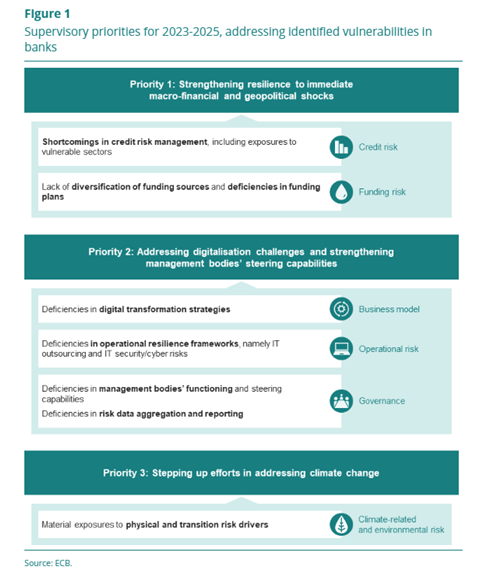- Home
- Blogs
- ECB in focus
ECB publishes supervisory priorities 2023-25
Author
Browse this blog post
Related news and insights
Blog Post: 04 April 2024
EU court’s judgment sheds new light on how the ECB should apply national administrative measures
Publications: 03 April 2024
Publications: 02 April 2024
Publications: 02 April 2024
Background
Against the current challenging macro-economic background, the ECB has reoriented its medium-term supervisory priorities in order to counteract vulnerabilities of credit institutions that were identified during the 2022 Supervisory Review and Evaluation Process (SREP).
The ECB published medium-term supervisory priorities for the first time in December 2021 (see our blog post here) spanning the period from 2022-2024.
While those supervisory priorities “remain suitable” in the ECB’s words, the emerging risks from the war in Ukraine and high inflation meant some adjustments were required.
With the notable exception of funding risk, which is a new addition, the 2023-2025 supervisory priorities mostly streamline and re-prioritise the existing medium-term supervisory priorities identified at the end of 2021.
 |
Priority 1: Strengthening resilience to immediate macro-financial and geopolitical shocks
While the 2022-2024 supervisory priorities on banks focused on banks emerging from the COVID-19 pandemic, the ECB has shifted its focus to the impact of the war in Ukraine and high inflation.
In light of the negative macro-economic outlook, the ECB’s primary objective is to ensure significant institutions are sufficiently resilient with regard to immediate shocks. The biannual stress test exercise conducted by the European Banking Authority (EBA), which is due in 2023, will support this effort.
Sub-priority 1: Shortcomings in credit risk management, including exposures to vulnerable sectors
The first prioritised vulnerability relates to credit risk and broadly addresses the issues identified in the 2022-2024 supervisory priorities. The ECB’s objective is for banks to eliminate shortcomings in credit risk management. Most supervisory activities planned to tackle the continued shortcomings are a continuation of last year’s priorities There are, however, some adjustments in line with the broadening of focus from the effects of the COVID-19 pandemic to also include the impact of the war in Ukraine and the broader macro-economic environment.
Sub-priority 2: Lack of diversification in funding sources and deficiencies in funding plans
The second sub-priority aims at improving diversification in funding sources and dealing with deficiencies in the funding plans of banks, taking into account changing funding conditions. It is a new priority and stems from the fact that the ECB has identified a high concentration of central bank funding at some institutions.
The move to include funding risk as a priority comes shortly after the ECB – in its monetary capacity – introduced a significant change to its targeted longer-term refinancing operations programme (TLTRO III) that provided favourable funding conditions throughout the pandemic.
The ECB will conduct a targeted review of TLTRO III exit strategies of banks with high reliance on TLTRO III funding as they diversify their funding sources and are more vulnerable to spikes in market funding costs.
Priority 2: Addressing digitalisation challenges and strengthening governance capabilities
Following on from the 2022-2024 supervisory priorities, the ECB wants to maintain a strong focus on banks tackling structural challenges with a view to ensure resilience and sustainability of banks’ business models.
Sub-priority 1: Deficiencies in digital transformation strategies
One major sub-priority that was kept from the 2022-2024 supervisory priorities aims to address deficiencies in digital transformation strategies, [and the] pressure from digital competitors from inside the financial sector but also outside it (bigtech companies). In particular, the ECB plans to publish its supervisory expectations on digital transformation strategies and the outcomes of a 2022 benchmarking exercise.
Sub-priority 2: Deficiencies in operational resilience frameworks, namely IT outsourcing and IT security/cyber risks
Another recurring sub-priority is ensuring that banks have robust outsourcing risk arrangements and IT security and cyber resilience frameworks. More digitalisation brings with it an increased reliance on technologies and third-party service providers for delivering banking services. The ECB aims to follow up on the measures they have already initiated and continue to review banks’ outsourcing arrangements and cybersecurity measures.
Sub-priority 3: Deficiencies in management bodies’ functioning and steering capabilities
The ECB continues to see deficiencies in management bodies’ functioning and steering capabilities which had already been identified as a vulnerability in the 2022-2024 priorities.The ECB expects banks to develop and swiftly implement sound action plans to remedy material deficiencies in functioning, oversight and composition of their boards in line with supervisory expectations.
Sub-priority 4: Deficiencies in risk data aggregation and reporting
Finally, the ECB has repeatedly identified deficiencies in risk data aggregation and reporting as a major issue affecting the quality of managerial steering and effective risk management. Banks have been slow in closing gaps and still fall short of supervisory expectations and the Basel principles for effective risk data aggregation and risk reporting.
The ECB intends to step up efforts in this regard with work across JSTs and targeted on-sight inspection campaigns.
Priority 3: Stepping up efforts in addressing climate change
With its final priority, the ECB highlights that banks’ need to increase efforts to address risks stemming from climate change. While this vulnerability was placed in a larger bucket of “emerging risks” in the 2022-2024 supervisory priorities, it now stands on its own, showing its importance on the ECB’s supervisory agenda.
This comes as no surprise following significant supervisory activity in 2022 including the climate stress test and thematic review on climate and environmental risks. Both exercises showed that, while banks made progress, there was still a significant gap to be closed to meet supervisory expectations. The ECB has already published a guide to good practices after the thematic review. It has announced that it would publish a similar set of good practices observed during the stress test. The ECB generally expects full compliance with supervisory expectations until the end of 2024.
Additionally, the ECB plans the following activities:
- Targeted reviews of banks’ compliance with reporting and disclosure obligations
- Review of reputational and litigation risks
- Preparatory work for banks’ transition planning and readiness for ESG mandates expected to be introduced by CRD VI.
Further Reading
The ECB’s 2023-2025 supervisory priorities can be found here.
Read our blog post on the 2022-2024 supervisory priorities here.

